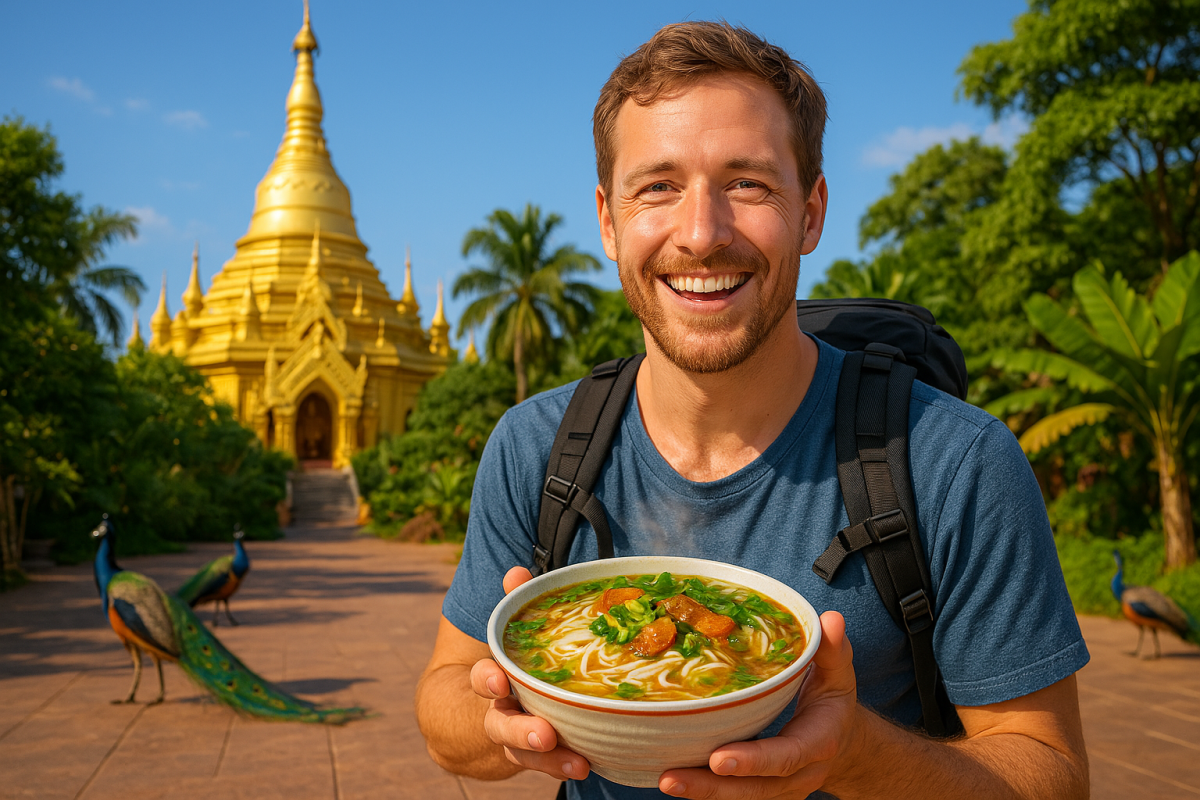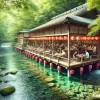Hey everyone, your trusty American backpacker guide. I've crisscrossed the globe, tasted exotic cuisines, and soaked up countless cultures, but my recent escapade to Dehong Dai and Jingpo Autonomous Prefecture in Yunnan, China, remains a standout. This isn't your typical tourist trap; this is raw, untamed beauty bordering Myanmar, with a staggering 503 kilometers of shared border – a hidden gem whispering tales of history, culture, and culinary adventures that'll leave you craving a return trip.
Mangshi: My First Impression of Dehong's Capital
My journey began in Mangshi, the prefecture's heart, a city teeming with the largest Jingpo population in all of China. The very moment I stepped off the bus, a dramatic monsoon downpour greeted me – a rather theatrical introduction to this enchanting borderland. The name "Dehong" itself, a melodic translation from the Dai language, signifies "the place downstream of the Nu River," perfectly capturing the essence of this unique and geographically significant location. The air hummed with an energy palpable and unlike anything I'd encountered before; a symphony of languages, a tapestry of cultures, a vibrant pulse that instantly captivated me. This was no ordinary Chinese city, but a crucible where ancient traditions met the modern world in a captivating dance. I could immediately sense a rich history waiting to be uncovered, a story etched in the very stones beneath my feet.
Mangshi's Culinary Delights: A Deep Dive into Guoqiao Mixian
No visit to Mangshi is complete without a headfirst plunge into its culinary treasures. My initiation began with Guoqiao Mixian, the renowned "over-the-bridge noodles," an experience that transcended mere sustenance and blossomed into a full-blown sensory symphony. The presentation itself was a work of art. A steaming, fragrant broth formed the foundation, upon which sat a small, perfectly poached chicken (or was it a pigeon? The mystery added to the allure). Bean sprouts, a delicate crunch of cuishao (crispy fried pork crackling), perfectly cooked quail eggs, the earthy notes of wood ear mushrooms – the components were meticulously arranged, a testament to the artistry of the dish. I even spotted some tender, delicately poached chicken breast alongside slices of succulent pork and fragrant ham. Then there were the noodles themselves – a perfectly balanced mound of chewy, springy mixian, waiting to be submerged into the aromatic broth. I also spotted some vibrant green cabbage nestled beneath the surface of the broth, waiting for the perfect moment to release its flavor into the mix. I carefully poured the broth over the noodles, watching as the ingredients harmonized, their flavors melding in a beautiful culinary dance.
| Ingredient | Detailed Description | My Detailed Impression |
|---|---|---|
| Broth | Rich, savory, deeply aromatic broth, likely simmered for hours | The complexity of flavors was mind-blowing, a symphony of tastes. |
| Noodles | Chewy, springy rice noodles, offering a delightful textural contrast | The perfect balance of texture and absorption of the broth's flavor. |
| Cuishao | Thinly sliced, deep-fried pork crackling, offering a sweet and salty crunch | Irresistibly crispy, offering a delightful textural and flavorful counterpoint. |
| Chicken/Pigeon | Delicate, perfectly poached poultry, adding a layer of richness | Incredibly tender and flavorful, expertly cooked to perfection. A possible pigeon! |
| Other Toppings | A carefully curated selection including bean sprouts, quail eggs, wood ear mushrooms, pork, and ham. | Each ingredient plays a vital role in the overall harmony of flavors and textures. |
| Cabbage | Gently wilted cabbage, subtly enhancing the broth’s richness | Added a delicate sweetness and a pleasant textural dimension. |
The first bite was an explosion of flavors – the savory broth, the chewy noodles, the satisfying crunch of the cuishao, the tender chicken, all working together in perfect harmony. I savored every mouthful, losing myself in the rich complexity of this culinary masterpiece.
Beyond the Bowl: Mangshi's Cultural Tapestry
But Mangshi offered far more than just culinary excellence. The city itself is a captivating tapestry woven from threads of Dai, Jingpo, and Han cultures. Their influence is evident in the architecture, the bustling markets overflowing with exotic goods, and the daily rhythm of life unfolding before my very eyes. I spent my second day exploring the awe-inspiring Meng Huan Golden Pagoda, a towering testament to Theravada Buddhism and the tallest pagoda of its kind in China – a breathtaking journey to the summit itself.
Meng Huan Golden Pagoda: A Spiritual Ascent
The ascent to the Meng Huan Golden Pagoda was an adventure in itself! The climb, though physically demanding, offered stunning panoramic views of Mangshi, revealing its beauty from an entirely new perspective. The pagoda's splendor, rebuilt in 2004, left me breathless. It is a towering testament to faith and a symbol of hope. This isn't just a pagoda; it's a living embodiment of faith and spiritual devotion. It houses over 300 priceless artifacts of Theravada Buddhism, including a sacred Bodhi tree descendant gifted from Sri Lanka – a direct lineage to the very tree under which Buddha attained enlightenment. The architecture is breathtaking, a unique fusion of traditional South Asian styles and local influences, creating a masterpiece that captivates the senses. Let's delve into the specifics:
- Height: 76 meters – a truly imposing structure visible from miles around.
- Base Diameter: 50 meters – providing ample space for contemplation and reverence.
- Architectural Style: A beautiful blend of South Asian Dai royal palace architecture and local influences, making it a unique and iconic structure.
- Artifacts: Over 300 Theravada Buddhist relics, each telling a story of faith, devotion, and cultural significance.
- Entry Fee: A remarkably affordable 38 RMB (approximately $5 USD), offering incredible value for such a spiritually enriching experience.
- The Bodhi Tree: A living descendant of the original Bodhi tree, under which Buddha gained enlightenment, adding a layer of historical and spiritual significance.
The feeling of peace and tranquility within the pagoda was palpable, a sacred space where the past and present intertwine, offering a moment of introspection and spiritual awakening.
Beyond the Pagoda: Exploring the Mengbana Xi Rare Plant Garden
After my spiritual journey at the Golden Pagoda, I ventured to the Mengbana Xi Rare Plant Garden, a 4A-level national tourist area. This wasn't just a garden; it was a living museum of biodiversity, showcasing a remarkable collection of exotic flora. The sheer variety of plant life was astounding, a vibrant display of nature's artistry. I spent hours wandering through its meticulously landscaped grounds, discovering rare and ancient trees, unique flowers, and, most remarkably, an exceptional collection of petrified wood (shuhua yu).
A Peacock's Paradise: Unexpected Encounters
Throughout my exploration of Mangshi, I was continually charmed by the unexpected sight of peacocks roaming freely, uncaged and unconfined, a testament to the harmonious coexistence of wildlife and human life. These weren't captive birds, but wild peacocks gracefully moving through the city, adding a touch of vibrant color and untamed beauty to the already captivating landscape. I witnessed breathtaking moments of a peacock spreading its magnificent tail feathers, a vibrant spectacle of color and movement that left me completely mesmerized. It was a truly unforgettable experience, one that highlighted the beauty of nature's unexpected gifts and the beauty of a city that respects the balance of its ecosystem.
Petrified Wood: A Glimpse into Geological History
The Mengbana Xi Rare Plant Garden also houses a truly remarkable collection of petrified wood, showcasing ancient trees transformed into stone. This rare phenomenon, the result of millions of years of geological processes, serves as a powerful reminder of the slow, inexorable march of time. The finest examples of petrified wood, I learned, originate from the China-Myanmar border region, but Myanmar, recognizing its immense cultural and scientific value, now protects it, prohibiting further excavation and export. These petrified trees, polished and gleaming, showcased a fascinating interplay of colors and textures. The process of transforming wood into stone is a truly remarkable geological event, a testament to nature's artistry and the relentless forces of time.
A Farewell to Mangshi: A Treasure to Be Rediscovered
My time in Mangshi left an indelible mark on my soul. It’s a place that has managed to avoid the pitfalls of excessive commercialization, preserving the unique charm and tranquility of a true border town. It's a place where history and culture seamlessly intertwine, a place where nature’s beauty is ever-present, a place that will continue to captivate and inspire long after I've left its borders. If you're searching for an off-the-beaten-path adventure that will enrich your soul and awaken your senses, Mangshi and Dehong await your discovery. It is a treasure waiting to be rediscovered, a destination that will surely leave you breathless and craving more.







